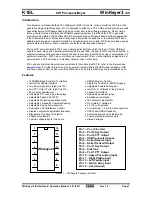
ML51/ML54/ML56
Sep. 01, 2020
Page
478
of 719
Rev 2.00
ML
51
/ML
54
/ML
5
6 S
E
RI
E
S
TECHNI
CA
L
RE
F
E
R
E
NC
E
M
A
NU
A
L
ML51/M
L54
/M
L56
Series
Tec
hnical Reference
Manual
Figure 6.9-3 Serial Port Mode 2 and 3 Timing Diagram
Transmission is initiated by any writing instructions to SBUF. Transmission takes place on TXD pin.
First the start bit comes out, the 8-bit data and bit TB8 (SCON.3) follows to be shifted out and then
ends with a stop bit. After the stop bit appears, TI will be set to indicate the transmission complete.
While REN is set, the reception is allowed at any time. A falling edge of a start bit on RXD will initiate
the reception progress. Data will be sampled and shifted in at the selected baud rate. In the midst of
the stop bit, certain conditions should be met to load SBUF with the received data:
1. RI (SCON.0) = 0, and
2. Either SM2 (SCON.5) = 0, or the received 9th bit = 1 while SM2 = 1 and the received data matches
“Given” or “Broadcast” address. (For enhancement function, see Section 6.9.3.4“Multiprocessor
Communication
” and Section 6.9.3.5“Automatic Address Recognition”.)
If these conditions are met, the SBUF will be loaded with the received data, the RB8(SCON.2) with the
received 9
th
bit and RI will be set. If these conditions fail, there will be no data loaded and RI will
remain 0. After above receiving progress, the serial control will look forward another 1-to-0 transition
on RXD pin to start next data reception.
Mode 3
Mode 3 has the same operation as Mode 2, except its baud rate clock source uses Timer 1 overflows
as its baud rate clocks. See Figure 6.9-3 for timing diagram of Mode 3. It has no difference from Mode
2.
Baud Rate
6.9.3.2
The baud rate source and speed for different modes of serial port is quite different from one another.
All cases are listed in Table 6.9-1 Serial Port 0 Mode / baud rate DescriptionThe user should calculate
the baud rate according to their system configuration.
In Mode 1 or 3, the baud rate clock source of UART0 can be selected from Timer 1 or Timer 3. User
can select the baud rate clock source by BRCK (T3CON.5). For UART1, its baud rate clock comes
only from Timer 3 as its unique clock source.
When using Timer 1 as the baud rate clock source, note that the Timer 1 interrupt should be disabled.
Timer 1 itself can be configured for either “Timer” or “Counter” operation. It can be in any of its three
running modes. However, in the most typical applications, it is configured for “Timer” operation, in the
















































